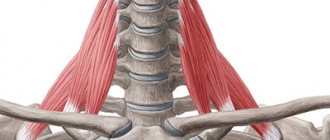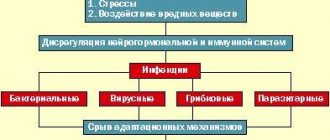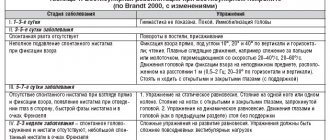Headache during menstruation
Quite a large number of women suffer from headaches during menstruation. This condition is called menstrual cephalgia. The sensations experienced by a woman during this period vary in intensity: from a completely tolerable and unstable feeling of pressure inside the head to severe migraines that can temporarily deprive one of his ability to work. Headaches are often accompanied by nausea, changes in the perception of smell and taste, increased sensitivity to sounds, mood instability and sleep disturbances.
Menstrual pain can occur 2 days before menstruation and 3 days after it. They usually do not pose a health hazard, however, if cephalgic episodes recur, you should consult a doctor. The reason for this condition is a sharp change in hormonal levels during the menstrual cycle, which is especially typical for women suffering from disorders of the hypothalamic-pituitary system, which regulates the production of hormones. The main causes of headaches during menstruation include the following:
- a sharp drop in the level of the hormone progesterone;
- change in water-salt balance;
- menstruation-related changes in prostaglandin levels;
- chronic iron deficiency anemia, which is often observed in women with heavy and prolonged menstrual bleeding.
Eating disorders with excess carbohydrates and saturated fats in the diet, and excessively frequent consumption of strong coffee predispose to the appearance of headaches during menstruation. Cervical osteochondrosis, blood clotting disorders, and previous head and neck injuries also increase the likelihood of menstrual cephalgia.
Up to contents
Causes of headaches at the end of the menstrual cycle
Severe pain occurs due to the fact that before menstruation a woman’s hormonal levels change. This causes not only headaches, but also many other unpleasant harbingers of menstruation.
https://youtu.be/QZXTlk-xqY0
Around the middle of the cycle, when a woman ovulates and the body prepares for fertilization, the amount of progesterone in the blood begins to increase several times. If fertilization of the egg does not occur, then the woman will begin her period after some time. A small percentage of women do not feel any changes in their body, and therefore menstruation does not cause pain or other very symptoms. Many people begin to have headaches and lower abdomen.
There may be other causes of headaches at the end of the month of the cycle. These include changes in the water-salt balance, which occurs shortly before the onset of critical days. Due to the increased level of the hormone estrogen in the female body, fluid excretion slows down significantly. If a woman suffers from swelling, then such a development of events may well provoke swelling of the soft tissues of the woman’s brain. In this case, the headaches will be aching or pressing in nature and arise directly in the back of the head, less often in the area of the crown. Blood pressure may increase significantly.
To put the water-salt balance in order in the body, shortly before your period, it is advisable to give up salty, smoked, pickled and fatty foods. In simpler terms, you need to exclude from your diet completely all foods that could retain water. At the same time, you can take special diuretics to ensure that all excess fluid is quickly removed from the woman’s body. Diuretic medications can only be prescribed by a specialist, because self-medication can further aggravate the situation and disrupt the water-salt balance. In particularly severe cases, even kidney failure may occur.
When the menstrual cycle ends, it can cause migraines in women. This often occurs in those who have a predisposition. Migraine is a strong painful sensation concentrated in the temples and eyes and has a strong pulsating character. The blood vessels of the head begin to contract very strongly and sharply, and then unclench. This is what causes pain to appear during menstruation or shortly before it begins. At the same time, various types of neurological manifestations can also be the cause. Only a specialist can treat the problem, because self-treatment often leads to serious consequences.
Headache in a pregnant woman
The causes of headaches in women during pregnancy and lactation may be different. In some cases they are associated with changes in hormonal levels, in others – with exacerbation of osteochondrosis of the cervical spine. Only a specialist can understand the true causes of the pathological condition. The complexity of this situation lies in the fact that during such a period the choice of medications against headaches is very limited. Therefore, only a doctor can prescribe the drug.
Up to contents
What to do for menstrual headaches
Consult a doctor if symptoms are severe
. Frequent and severe headaches during menstruation should be a reason to consult a doctor, regardless of the woman’s age. Consultation with a specialist is also required if the nature and duration of pain changes, new symptoms appear, discomfort persists during the subsequent cycle, or disturbances in the rhythm of menstruation.
Lead a healthy lifestyle
. Women prone to headaches are recommended to take evening walks, follow a daily routine, get enough sleep at night and be physically active. Don't forget to drink enough fluid. It is advisable to limit foods that are difficult to digest and promote fluid retention in the diet, and reduce the number of dishes with “fast” (easily accessible) carbohydrates. It is recommended to minimize or eliminate alcohol consumption and try to give up bad habits. On the recommendation of a doctor, you can go for a medical massage of the back, neck, and head.
Take medications recommended by your doctor
. To relieve headaches, antispasmodics and non-steroidal anti-inflammatory drugs are often used. For concomitant hypertension, antihypertensive drugs are indicated, and for anemia, a therapeutic diet and iron-containing medications are usually prescribed. For migraines, the doctor prescribes the correct therapy: anti-migraine drugs, triptans. Medications should only be taken with the permission of a doctor.
Up to contents
Motrin® for headaches
Motrin® is a complex action drug that helps relieve headaches for twelve hours. This product has a high safety profile and is approved for sale in pharmacies without a prescription.1 To achieve the best effect and maintain the correct dosage, before using it, you must read the instructions and consult your doctor.
Up to contents
The information in this article is for reference only and does not replace professional advice from a doctor. To make a diagnosis and prescribe treatment, consult a qualified specialist.
1 According to the instructions for medical use of the drug Motrin®.
Premenstrual syndrome (PMS)
Blackheads (acne)
Diarrhea
23774 11 February
IMPORTANT!
The information in this section cannot be used for self-diagnosis and self-treatment.
In case of pain or other exacerbation of the disease, diagnostic tests should be prescribed only by the attending physician. To make a diagnosis and properly prescribe treatment, you should contact your doctor. Premenstrual syndrome: causes of occurrence, what diseases it occurs with, diagnosis and treatment methods.
Definition
Tearfulness, irritability, unreasonable anger (in the opinion of others), pain in the abdomen and lower back, feelings of melancholy and anxiety, headache, swelling - these and many other symptoms are associated with the development of premenstrual syndrome, or PMS. Is PMS a condition that needs to be treated?
Premenstrual syndrome is a complex of pathological symptoms that includes a variety of psycho-emotional, somatovegetative and metabolic-endocrine manifestations that begin during the luteal phase of the cycle, which lasts approximately 14 days before the onset of menstruation, and disappear in its first days.
Thus, all the symptoms of PMS can appear either immediately after ovulation or one or two days before the start of the next menstruation.
Types of PMS
Depending on which symptoms predominate in the manifestation of premenstrual syndrome, the following forms are distinguished:
- edematous;
- cephalgic;
- crisis;
- neuropsychiatric;
- atypical.
The edematous form of PMS is characterized by swelling of the face, legs, fingers and associated weight gain.
Possible manifestations include engorgement of the mammary glands, sweating, itching and functional bowel disorders (constipation, diarrhea, increased gas formation). All of these symptoms disappear at the beginning of menstruation and rarely require seeking medical help. The cephalgic form of PMS is characterized by severe headaches, often unilateral, pulsating, aggravated by movement. Such pain is accompanied by irritability, increased sensitivity to smells, aggression, nausea, and pain in the heart. The cephalgic form of PMS occurs in women who have suffered a traumatic brain injury or neuroinfection, as well as those suffering from arterial hypertension and other cardiovascular diseases. The pain goes away at the end of the luteal phase of the menstrual cycle.
The crisis form of PMS is characterized by a predominance of sympathoadrenal crises (something similar to panic attacks), accompanied by increased blood pressure, increased heart rate, and pain in the heart without changes on the ECG. Such attacks may result in increased urination.
The neuropsychic form of PMS includes a number of symptoms that a woman usually does not pay attention to. They regularly appear before the onset of menstruation and are a reason to consult a doctor: irritability, tearfulness, insomnia, aggression, depression, fatigue, sexual dysfunction, suicidal thoughts and various hallucinations.
The neuropsychiatric form is often combined with other forms, especially in severe cases of PMS.
The atypical form of PMS is rare and occurs under the guise of other diseases - bronchial asthma, ulcerative gingivitis or stomatitis, iridocyclitis, myocardiopathy.
Based on the severity of the course, a mild form of PMS is distinguished - up to four symptoms appear 2–10 days before menstruation, with up to two symptoms being severely expressed.
In severe PMS, more than five symptoms appear 3-14 days before the start of menstruation, and many of them are severe.
Possible causes of premenstrual syndrome
The frequency of PMS depends on the age of the woman. If under the age of 30 PMS symptoms occur in only 20% of women, then after 30 years PMS occurs in almost every second woman.
Women who are emotionally labile, have an asthenic build, and are often underweight are predisposed to the development of premenstrual syndrome.
Risk factors for developing PMS also include:
- frequent stressful situations at home and at work;
- complicated childbirth;
- history of abortion;
- surgical interventions;
- neuroinfections;
- frequent changes in climate zones;
- the presence of chronic gynecological diseases.
According to modern data, changes in sensitivity to the hormone progesterone are of decisive importance in the development of negative symptoms.
The role of the trigger mechanism in the process of PMS occurrence is played by the normal change in the level of sex hormones during the menstrual cycle. In the second half of the cycle (luteal phase), progesterone has the main effect on a woman’s body. Progesterone indirectly affects the dynamic change in the level of serotonin secretion. It is this system that provides mood regulation at the neuronal level.
It is believed that during the luteal phase of the menstrual cycle, there is an increase in the processing time of negative emotions in the brain structures and a decrease in control over the level of expression of emotions.
Another mechanism affecting changes in serotonin levels in the brain is constant stress, prolonged experiences of unresolved conflict situations, fear, and anticipation of real or imaginary events. Anxiety in most cases increases appetite, and “eating a bad mood” leads to the development of flatulence and other dyspeptic disorders (constipation and diarrhea), which contributes to premenstrual syndrome.
Hereditary predisposition plays a huge role in the development of PMS.
Which doctors should I contact for PMS?
If manifestations of PMS interfere with leading a full social and personal life, to solve this problem you should contact.
It is important to exclude the presence of other somatic pathologies that may worsen the course of the second phase of the menstrual cycle. To do this you need to contact. If necessary, the doctor will refer you for the necessary laboratory and instrumental examinations and consultations with specialized specialists.
If an organic cause of the disease is not found, it is necessary to consult a psychiatrist to determine tactics for overcoming anxiety and other stressful conditions.
Diagnostics and examinations for PMS
During the diagnosis of premenstrual syndrome, an important role is played by the patient's keeping a diary over several cycles.
It notes all the symptoms of PMS, their severity in points from 0 to 10. In order to exclude somatic and neuroendocrine pathologies, a complex of laboratory and instrumental diagnostics is performed depending on the symptomatic picture.
- Hormonal blood test: follicle-stimulating hormone (FSH), luteinizing hormone (LH), prolactin, testosterone, estradiol, adrenocorticotropic hormone (ACTH), thyroxine (T4), triiodothyronine (T3), thyroid-stimulating hormone (TSH).









